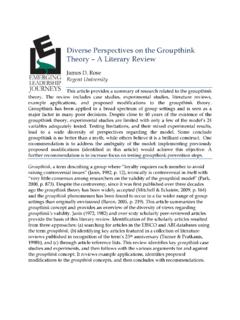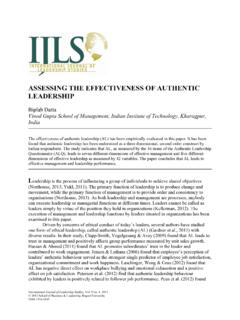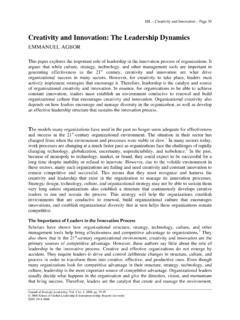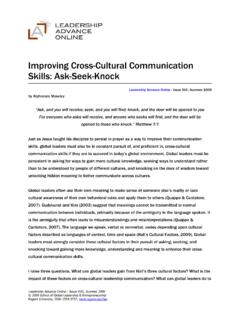Transcription of Shared Leadership: Is it Time for a Change?
1 Shared Leadership: Is it Time for a Change? michael D. Kocolowski Regent University This paper investigates Shared leadership and seeks to determine if more organizations should consider adopting a Shared leadership model. Leadership affects the success and failure of every type of organization, and the complexity of today s business environment makes leadership increasingly more challenging. It is becoming more difficult for any single individual to possess all of the skills and abilities required to competently lead an organization today. A review of the literature indicates that while Shared leadership has been practiced in some form for centuries, research on the subject is still in its infancy.
2 An abundance of Shared leadership studies fall in the domains of healthcare and education, two industries especially open to the concept. Studies outside these two industries are scarce, but include a diverse collection of organization types and groups. While research indicates that Shared leadership has its challenges and can be difficult to implement, overall the benefits of Shared leadership hold promise. Organizations of all types should take notice and consider implementing a Shared leadership approach. Leadership is a pivotal issue that affects the success and failure of every organization, country, and religious movement. The speed of change and complexity in today s business environment make leadership increasingly exigent, placing unrealistic expectations on heroic leaders (Yukl, 2006).
3 Ostensibly, it is becoming more difficult for any single individual to possess all of the skills and abilities required to competently lead organizations today (O Toole, Galbraith, & Lawler, 2002). O Toole et al. affirmed, Frequently, organizations learn the hard way that no one individual can save a company from mediocre performance and no one individual, no matter how gifted a leader, can be right all the time (p. 67). Pearce (2007) pointed out, As organizations have steadily progressed into the knowledge economy we can no longer rely on simple notions of top down, command-and-control leadership, based on the idea that workers are merely interchangeable drones (p. 355). Hence, this paper investigates the case for Shared leadership and seeks to determine if more organizations should consider adopting a Shared leadership model.
4 Emerging Leadership Journeys, Vol. 3 Iss. 1, 2010, pp. 22-32. 2010 School of Global Leadership & Entrepreneurship, Regent University ISSN 1930-806X, Kocolowski/EMERGING LEADERSHIP JOURNEYS 23 An initial search of the phrase Shared leadership in the Academic OneFile database yielded 75 articles in academic journals. The search results of similar phrases are as follows: distributed leadership (24), collective leadership (22), horizontal leadership (0), team leadership (97), and leadership team (182). An evaluation of all articles referenced took place, followed by a thorough search in ABI/Inform, Academic Search Complete, and Business Source Complete using the identical terms and phrases.
5 Again, I examined all articles and their reference lists for relevance and applicability to the topic. When no new articles turned up, I considered the search complete. Many of the studies on Shared leadership fall in the domain of healthcare (Jackson, 2000; Konu & Viitanen, 2008; Merkens & Spencer, 1998; Spooner, Keenan, & Card, 1997; Steinert, Goebel, & Rieger, 2006) and education (Boardman, 2001; Hall, 2001; Meyers & Johnson, 2008; Prather, Hartshorn, & McCreight, 1988; Rice, 2006; Wallace, 2001). Studies outside these two domains are scarce, but include a diverse collection of organization types and groups: new ventures (Ensley, Hmieleski, & Pearce, 2006), road maintenance teams (Hiller, Day, & Vance, 2006), churches (Wood, 2005; Wood & Fields, 2007), equipment and engine manufacturing (Anderson, Anderson, & Mayo, 2008), technology (Hsu & Sharma, 2008), local government (Berman, 1996), consulting teams (Carson, Tesluk, & Marrone, 2007), sales teams (Mehra, Smith, Dixon, & Robertson, 2006; Perry, Pearce, & Sims, 1999;), police departments (Steinheider & Wuestewald, 2008), and banks (Walker, Smither, & Waldman, 2008).
6 While research indicates that Shared leadership has its challenges and can be difficult to implement, overall, the benefits of Shared leadership often outweigh the limitations. Organizations of all types should take notice and consider implementing a Shared leadership approach. Shared Leadership Sally (2002) pointed out that Shared leadership has existed since ancient times: Republican Rome had a successful system of co-leadership that lasted for over four centuries. This structure of co-leadership was so effective that it extended from the lower levels of the Roman magistracy to the very top position, that of consul (p. 84). However, over the course of history most organizations have been led by one central leader in a hierarchal fashion (Wood, 2005).
7 Indeed, O Toole et al. (2002) observed, For most people, Shared leadership is counterintuitive: leadership is obviously and manifestly an individual trait and activity (p. 66). Furthermore, they added, The identities of American corporations are often viewed as mere reflections of the personalities of their leaders: entire organizations are portrayed as shadows of the Great Men who sit in the chief executive chairs (p. 66). Bennis (1999) complained, In our society leadership is too often seen as an inherently individual phenomenon (p. 72). This viewpoint has unfortunate side effects. The common assumption that one leader (the CEO) rules everything is responsible for the singular manner in which leadership is taught in business schools and the fact that academic research literature on Shared leadership is sparse (O Toole et al.)
8 However, times may be changing. O Toole (2001) suggested that leadership is not only an individual trait, but is also an institutional trait. Avolio, Walumbwa, and Weber (2009) observed that Shared leadership is gaining prominence in organizations as team-based structures replace hierarchical structures. Furthermore, O Toole et al. (2002) affirmed, The trend over the last half-century has been away from concentration of power in one person and toward Emerging Leadership Journeys, Vol. 3 Iss. 1, 2010, pp. 22-32. 2010 School of Global Leadership & Entrepreneurship, Regent University ISSN 1930-806X, Kocolowski/EMERGING LEADERSHIP JOURNEYS 24 expanding the capacity for leadership at the top levels of corporations (p.)
9 67). Moreover, Yukl (2006) recognized that those who subscribe to Shared leadership approaches understand that important decisions about what to do and how to do it are made through the use of an interactive process involving many different people who influence each other (p. 4). Defining Shared Leadership The quest for developing an integrative definition of Shared leadership has been elusive. Avolio et al. (2009) declared that the most widely cited definition of Shared leadership comes from Conger and Pearce (2003): A dynamic, interactive influence process among individuals in groups for which the objective is to lead one another to the achievement of group or organizational goals or both (p.
10 1). Conger and Pearce added, This influence process often involves peer, or lateral, influence and at other times involves upward or downward hierarchical influence (p. 1). It is important to recognize the terms often associated with Shared leadership. In research literature, Shared leadership, collective leadership, and distributed leadership are used interchangeably, while team leadership is commonly viewed as a slightly different stream of research (Avolio et al., 2009). However, Shared leadership definitions often include the term team, coupled with the concept of a process, property, or phenomenon. Carson et al. (2007) examined antecedent conditions that lead to the development of Shared leadership in a sample of 59 consulting teams comprised of MBA students and concluded, Shared leadership refers to a team property whereby leadership is distributed among team members rather than focused on a single designated leader (p.
















